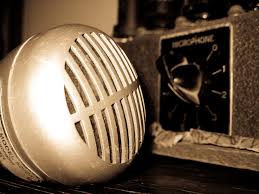
Why Bullet Mics in Home Studios are Not Tops for Recording Harmonica
In a recent post to the Harp-L list, the poster said that he’d found a recording setup that he liked: a Green Bullet mic on a stand, into which he played from over a foot (about half a meter) away. I’m glad the guy got a recorded sound that he likes, but I’m duty-bound to say that I would never record an acoustic (or for that matter, amped) harp this way if I had a choice.
Let’s start with the obvious: recording acoustic harp and amplified harp are two different things, and a Bullet mic is far better for the latter than the former. The Bullet’s frequency range tops out at about 6 kHz, which is in the high midrange. On the plus side, you’re cutting out the high frequencies where recorded harp can be pretty screechy; on the down side, you’re cutting ALL of those frequencies out, so you’re missing the high end gloss and sheen that a harmonica can produce. The reason harp players like bullet mics so much is that they sound good coming through a tube guitar amp, mainly because tube amps tend to top out in the same frequency range as a bullet mic, and bullet mics distort in a very pleasing way when hand-held. (Human ears love distortion, which in itself does a lot to explain the attraction of electric guitars.) I have never, repeat never, heard a great sound from a bullet taken direct to the board, and I’ve heard a lot of guys try, including John Sebastian Jr. on a live broadcast from the Rock & Roll Hall of Fame, where the sound techs generally know what they’re doing.

It’s true that this setup avoids a proximity effect–a big boost in the low frequencies–but that’s not due to the mic. You have to be close enough to kiss the mic to get a proximity effect. If you record into an open mic from 18 inches away, you won’t get a proximity effect no matter what mic is on the stand. Anyway, a proximity effect isn’t much of a problem in recording harmonica. Proximity effects show up only in the low frequencies, and it’s easy to EQ those out of a recorded harmonica track without damaging the rest of the signal. That’s one reason why Toots Thielemans always asks for a Shure SM58 in the studio, which he hand-holds. Yes, he gets a lot of proximity effect that way, but the engineer can easily take the added bass out of the mix.
Beyond that, with an open mic on a stand, you’re inevitably letting a lot of the room sound into the mic. If your room is treated to be neutral-sounding, or it just happens to be a great-sounding room, that’s cool. Most rooms outside of professional recording studios sound like hell, with standing waves producing frequency bumps and dips all over the place. That’s certainly the way it works in my house. I’ve managed to improve the situation in my home studio with a portable enclosure that blocks out sound from the sides and back, but without that I’d never try recording into an open mic in my house again (unless I truly did not care about the quality of the sound, which for a practice session I might not–I’ve used all kinds of junky stuff to record practice sessions).
That’s my story and I’m stickin’ to it. That said, in the end, the sounds you make have to inspire you before they inspire anyone else. If you want to record through a Green Bullet into the board, and you like what you hear, go for it. If you get to the point where your recorded sound isn’t inspiring you anymore, try a hand-held Audix Fireball V (which also exhibits very little proximity effect, even hand-held), or a vocal mic or large diaphragm condenser mic on a stand with an enclosure around it to take the room out of the sound. Either of those solutions is relatively inexpensive, and will give you a wider range of tones to work with in your recordings.
Related Posts
Leave a Reply
You must be logged in to post a comment.
WHAT’S NEW
Categories
- Audio/Video
- Blog
- Blue Future
- Digitech RP Tricks and Tips
- Discography, CDs, Projects, Info, Notes
- Featured Video
- For the Beginner
- Gallery
- Hunter's Effects
- Hunter's Music
- Huntersounds for Fender Mustang
- Meet the Pros
- More Video
- MPH: Maw/Preston/Hunter
- My Three Big Contributions
- Player's Resources
- Pro Tips & Techniques
- Recommended Artists & Recordings
- Recommended Gear
- Recorded Performances
- Reviews, Interviews, Testimonials
- The Lucky One
- Uncategorized
- Upcoming Performances
- Zoom G3 Tips and Tricks